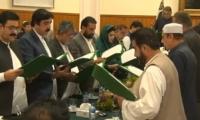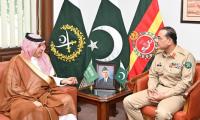Although India may be shining upon its middle class and Hindu nationalists, a Kali Yuga – the mythical Dark Age – is descending on Muslims and other religious minorities in the country.
The discrimination against them has been gradually institutionalised and turned into a national creed. At a time when India should be self-assured, confident and at peace with itself and its neighbours, it is showing increasing signs of a deep-seated inferiority complex.
Interestingly, this is happening at a time when the much-maligned Pakistan is making an effort to integrate its religious minorities and become more inclusive. Its provincial legislatures are passing law after law to protect minorities. Its courts are interpreting laws in a minority-friendly manner, forcing the authorities to protect and reconstruct minorities’ places of worship. Its political leaders are participating in the religious festivals of minorities and making statements that would have been unimaginable a few years ago.
It appears that Hindu nationalists have finally won – or, are on the brink of winning – the battle for the soul of India, defeating the ghost of Gandhi whom they had assassinated 69 years ago. In the words of Christophe Jaffrelot: “Mahatma Gandhi looked at the Indian nation as, ideally, a harmonious collection of religious communities all placed on an equal footing. He promoted a syncretic and spiritual brand of the Hindu religion in which all creeds were bound to merge, or converge. Even though the leaders of India’s minorities – especially Muslims – resisted this universalist appeal – in part because Gandhi articulated his views in a thoroughly Hindu style”.
The ideology of Hindu nationalism, on the other hand, equated India’s national identity with Hinduism. According to their worldview: “Indian culture was to be defined as Hindu culture, and the minorities were to be assimilated by their paying allegiance to the symbols and mainstays of the majority as those of the nation”. The fear of Hindu nationalism becoming ascendant in India was a major part of the Muslim League’s narrative, first for its struggle to ensure the constitutional protection of Muslims and, after failing to obtain such guarantees, for a separate homeland in Muslim-majority areas.
If Gandhi was such a staunch Hindu and many of his followers considered him a deity, what was his problem with Hindu nationalists? For Gandhi, Hinduism was a moral and spiritual system while Hindu nationalists believe Hinduism is a tribe that has the right to enjoy complete supremacy in India because of its history and its numbers. When a religion is separated from its spiritual essence and used to mark a tribal identity, it turns into a dark force. This is what we are witnessing in India and many other places in the world today.
According to Carl Jung, all humans and social groups have a dark side to them. We suppress these dark energies to remain human. But at times, they overpower us and make us do things we might have considered unimaginable. Both India and Pakistan have reasons to be afraid of their own shadows. While the British exited after three centuries in India without firing a single shot, the two countries underwent a bloodbath and mass exodus of Hindus from Pakistan and Muslims from India. The ethnic cleansing and atrocities happened at such a large scale and with such ferocity that in modern history, the episode can only be compared with the Holocaust.
As part of the project to build nation-states, the two countries have developed two different – and diametrically opposed – myths of origin. As Ashis Nandy, India’s most celebrated sociologist, writes: “This story is not concerned with history; it is concerned with the future of ‘reconstructed’ pasts, with the myths that frame the fate of South Asia as it enters the twenty-first century. It is actually a story which has many of the ingredients that constitute an epic – a cast of millions, memories of wars and an exodus that have taken the toll of someone near to virtually everyone, and anger over lost or stolen patrimonies”.
Two sets of people have paid an enormous price for the hostility between the two states – those who left and those who were left behind, ie the migrants and the minorities. In India, those who left for Pakistan or were forced to migrate, are termed as enemies by Indian law (under the Enemy Property Act 1968) and their properties cannot be inherited by their children who opted to stay.
Hundreds and thousands of peoples who crossed the borders in 1947 were not allowed to return to collect their belongings or revisit their homes or cities. Those who migrated as infants or children are now in their seventies and eighties. But these senior citizens have also been denied their last chance to revisit their places of birth. The two mighty nuclear powers feel threatened by this generation because they can threaten national myths.
There is no place for Muslims in the history of India, which has been constructed by Hindu nationalists. They are bound to remain aliens and outsiders unless they are willing for ghar wapsi, that is returning to their original faith – Hinduism.
As Shoaib Daniyal, an Indian journalist, notes: “Most worryingly, Akbar has been a political untouchable since 1947. India has no roads, roundabouts, airports or museums named after Akbar; no equestrian statues of a man who was the most powerful sovereign in the world during his time. (The Akbar Road at the centre of this debate is a name bestowed by the British)”.
According to Daniyal, Maharana Pratap, on the other hand, is remembered through the airports, bus terminals and roads named after him while the equestrian statues of Pratap abound across India, with one even making it to parliament. This is despite the fact that he was the ruler of a tiny principality and was rather easily defeated by Akbar.
Seven decades after Independence, Muslims are still viewed with suspicion in India and Hindus in Pakistan. In India, Muslims are bearing the full brunt of the rising tide of Hindu nationalism and are under attack from vigilante cow protectors (Gau Rakhshaks) who lynch and even murder them – and, sometimes, low-caste Hindus – on suspicion of smuggling cows or consuming their meat. The socio-economic status of Muslims paints a bleak picture and hint at the structural injustice and exclusion.
Pakistan hardly has anything better to report. According to an international index, Pakistan is the eighth most dangerous country for minorities. The state’s discriminatory policies have permeated into all spheres of society, exacerbating the already existing forms of exclusion and making members of minority communities fear their neighbours. While terrorism has affected all Pakistanis, it has disproportionally ravaged the lives of minorities who were already under attack from religious extremists. Terrorists have attacked their properties, religious congregations, places of worship and community leaders, forcing thousands of people to leave their homes and relocate to safer places.
However, now Pakistan appears inclined to tread a different path. A newfound optimism is evident among minority communities and rights activists. My recent interaction with young people belonging to minority groups showed that they see a bright future for themselves in this country. They feel that Muslims not only stand with them but are at the vanguards of their struggle for rights.
If India had won its freedom for its people and Pakistan was created to ensure social justice, there should be no place for discrimination on their lands.
The writer is an anthropologist and development professional.
Email: zaighamkhan@yahoo.com
Twitter: @zaighamkhan
A woman walks past a building of the International Monetary Fund. — AFP/FileThe annual and spring meetings of the...
Late Benazir Bhutto's daughter Asifa Bhutto Zardari addresses the Christian community in Bihar Colony on January 23,...
Representational image. — PexelsWater is an important scarce natural resource that is required for several everyday...
Pakistani employees of online marketplace company Kaymu at work in Karachi. — AFP/FileThe true spirit of development...
India uses Afghanistan as a backstage area to carry out terrorist attacks against Pakistan
Another report by the Pakistan Institute of Peace Studies states that 78 per cent of attacks have been carried out by...







